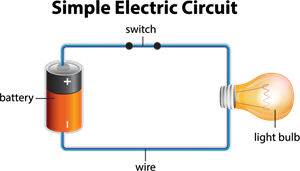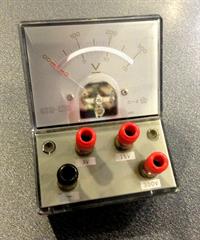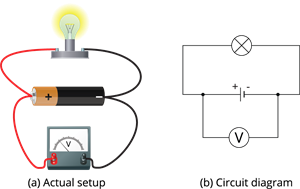PDF chapter test TRY NOW
An electric circuit cannot be connected randomly from one terminal to another terminal of a cell. For example, an electrical device, a bulb or a small fan works due to the current passing through them.

An electric circuit
A specific amount of electrical energy supplied by the cell or any other electrical energy source is turned into other forms of energy such as light, heat, mechanical, etc. The amount of electrical energy converted to other forms of energy depends on the potential difference across the circuit.
Each coulomb of charge flowing through the light bulb or any other appliance is determined by the potential difference across the device or component in the electrical circuit.
The electric potential difference between two points is defined as the amount of work done in moving a unit positive charge from one point to another point against the electric force.
The potential difference between two points
If charge \(Q\) is moved from point \(A\) to point \(B\), then \(W\) is the work done to move the charge from one point to another (\(A\) to \(B\)).
The formula is given as,
Where \(V\) is the potential difference, \(W\) is the work done, and \(q\) is the charge in coulomb (\(C\)).
Unit:
The SI unit of potential difference is volt (\(V\)).
The potential difference between two points is one volt if one joule of work is done in moving one coulomb of charge from one point to another against the electric force.
Measuring device:
A voltmeter is a device used to measure the potential difference. The device is connected parallel to the electrical component of a circuit to measure the potential difference.
A voltmeter is a device used to measure the potential difference. The device is connected parallel to the electrical component of a circuit to measure the potential difference.

Voltmeter
A battery, a voltmeter and a light bulb are connected to make a simple electric circuit, as shown below.

Connection of voltmeter in a circuit with a diagram
In the given circuit connection, the voltmeter's positive (\(+\)) red terminal is connected to the circuit's positive terminal, and the negative (\(–\)) black terminal is connected to the circuit's negative terminal across the component.
Difference between electromotive force and potential difference:
Electromotive force and the potential difference may appear the same as they are measured in volt. However, these two terms are not the same.
The e.m.f refers to the voltage developed across the terminals of an electrical source when it does not produce current in the circuit.
Potential difference refers to the voltage developed between any two points (even across electrical devices) in an electric circuit when there is current in the circuit.
Potential difference refers to the voltage developed between any two points (even across electrical devices) in an electric circuit when there is current in the circuit.
